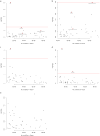A large electronic-health-record-based genome-wide study of serum lipids
- PMID: 29507422
- PMCID: PMC5942247
- DOI: 10.1038/s41588-018-0064-5
A large electronic-health-record-based genome-wide study of serum lipids
Abstract
A genome-wide association study (GWAS) of 94,674 ancestrally diverse Kaiser Permanente members using 478,866 longitudinal electronic health record (EHR)-derived measurements for untreated serum lipid levels empowered multiple new findings: 121 new SNP associations (46 primary, 15 conditional, and 60 in meta-analysis with Global Lipids Genetic Consortium data); an increase of 33-42% in variance explained with multiple measurements; sex differences in genetic impact (greater impact in females for LDL, HDL, and total cholesterol and the opposite for triglycerides); differences in variance explained among non-Hispanic whites, Latinos, African Americans, and East Asians; genetic dominance and epistatic interaction, with strong evidence for both at the ABO and FUT2 genes for LDL; and tissue-specific enrichment of GWAS-associated SNPs among liver, adipose, and pancreas eQTLs. Using EHR pharmacy data, both LDL and triglyceride genetic risk scores (477 SNPs) were strongly predictive of age at initiation of lipid-lowering treatment. These findings highlight the value of longitudinal EHRs for identifying new genetic features of cholesterol and lipoprotein metabolism with implications for lipid treatment and risk of coronary heart disease.
Conflict of interest statement
Figures



References
-
- Castelli WP. Cholesterol and lipids in the risk of coronary artery disease--the Framingham Heart Study. Can J Cardiol. 1988;4(A):5A–10A. - PubMed
-
- Kannel WB, Dawber TR, Kagan A, Revotskie N, Stokes J. Factors of risk in the development of coronary heart disease--six year follow-up experience The Framingham Study. Ann Intern Med. 1961;55:33–50. - PubMed
Publication types
MeSH terms
Substances
Grants and funding
LinkOut - more resources
Full Text Sources
Other Literature Sources

